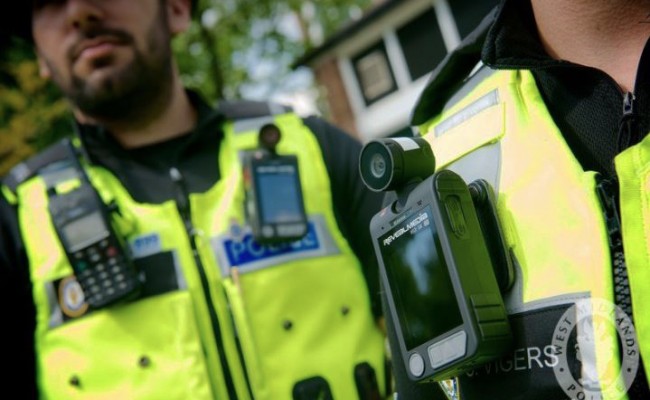The world is in the grips of what some are calling ‘a police body camera revolution’ and Australia is in the thick of it. Victoria began its rollout of body-worn cameras to all frontline police officers in April this year. This came after ‘one of the world’s biggest rollouts of body-worn cameras’ in Queensland, and early efforts in South Australia and Tasmania. The Northern Territory has not stopped at giving cameras to police; it is now also handing them out to public housing security officers. The stealthy creep of body-worn cameras beyond the policing realm is also occurring in Victoria and Queensland, where health workers are being kitted out with the devices. This might be an unalloyed good if we were confident that all body-worn cameras do is improve police behaviour and community safety. Unfortunately, it’s not quite that simple.
We cannot be sure that body-worn cameras achieve what their proponents claim they do. The available empirical data throws up as many questions as it answers. Granted, some early studies – like those in in Rialto, California, and Orlando, Florida – suggest that the cameras do curb excessive police use of force. Yet the latest data tells a different story. In Washington D.C., a randomised-controlled trial involving over 2,200 police officers resulted in the dispiriting conclusion that body-worn cameras don’t change police behaviour even a bit. The researchers, comparing officers wearing cameras to those not wearing them, found no statistically significant differences between their behaviour (as measured by uses of force and civilian complaints against police).
Two other recent studies, both headed by the world’s leading researcher on body-worn cameras, delivered more bad news. A trial covering over 4,200 officer shifts produced results that showed no significant differences in the number of civilian complaints during those shifts where officers were wearing cameras, and those that were camera-free. The most optimistic explanation the researchers could offer for the puzzling results was that there might have been some dilution of effects between the camera and the non-camera groups.
Findings in a similarly modelled study, focussed on use of force both against and by police officers, cast serious doubt on the so-called ‘civilizing effect’ of body-worn cameras, whereby the presence of the camera is claimed to motivate better behaviour in civilians, as well as police. Rather than confirming this effect, the study suggests that the presence of a camera actually increases the likelihood that a civilian will assault a police officer. Furthermore, the study found that the cameras had no effect on the other side of the equation – police uses of force against civilians. Putting it simply, body-worn cameras do not stop police assaulting civilians but they do make it more likely that civilians will assault police.
Admittedly, data can be misleading, especially in a context with the variables that policing has. Just because three recent studies have returned troubling results, it does not mean we should necessarily be throwing body-worn cameras into the bin with polygraph machines and other out-of-vogue policing hardware. Rather these recent studies should cause policy makers to slow down, take stock, and consider exactly how much Australia wants to invest in devices that no one appears to fully understand.
More predictably, but no less worryingly, technological advances are increasing the data-gathering power of body-worn cameras, and amplifying the risk of unwarranted intrusions into the privacy of civilians. Civil liberties groups in the US have been particularly troubled by revelations that body-worn cameras may soon be linked to real-time facial recognition software (the camera companies already have the capabilities to do this, it is just a question of when the temptation becomes too hard to resist for law enforcement).
With increasing government control of our biometric data – in the US, researchers have estimated that state, local and federal databases house searchable facial portraits of 50 per cent of the nation’s adult population – this would give Big Brother the ability to know where you are every time you pass a police officer. As one scholar in the field has said: ‘It’s essentially running a search on everybody walking past a given officer on his patrol. There’s no notice given to these people, and there’s certainly no consent.’
There is also the possibility that facial recognition technology will be applied retrospectively to the hundreds of thousands of hours of body-worn camera footage already in the possession of police (Queensland alone has 130 terabytes of data, amounting to about 155,000 hours of footage). With all this in mind, there is but cold comfort in the Prime Minister’s recent denial that the Australian Government is in the business of mass surveillance.
Then again, it is not just the government who might have access to this data. Victoria Police will store its data on Axon’s cloud station Evidence.com. After the Facebook-Cambridge Analytica data leak, we might well be worried by the prospect of entrusting private companies with such highly sensitive data – think recorded victim statements, confessions and footage of people injured or even dying. Certainly plenty of people in the US were troubled when it was revealed that Axon uses the data on Evidence.com to develop controversial predictive policing software. Presumably, thousands of Victorians’ data is soon going to be subjected to the same treatment, although Victoria Police has not told us that.
Body-worn cameras are big business. The global market for body-worn cameras is expected to be close to $1 billion (US) by 2023. Australia comprises just a sliver of this market, but relatively speaking our spending is significant. The Victorian rollout is part of a $227 million investment in what Lisa Neville, the State Minister for Police, likes to call ‘high-tech cops’. But what’s good for business is not always good for criminal justice policy (think of the mass privatisation of prisons in the US).
It is easy to forget that the world’s biggest producer of body-worn cameras – Axon, formerly known as Taser International – got its break making and aggressively marketing electronic weapons that stun, and sometimes kill, people. Axon is now embroiled in controversy over its financial links to US police chiefs in departments who have signed up for Axon’s cameras. Axon’s vice president, Steve Tuttle, once boasted that soon ‘every cop will be a Robocop’. Tuttle was probably thinking about how good this sounded to his shareholders, which might be why he failed to realise how positively terrifying it sounds to everybody else. Everybody except Victoria Police that is, who recently asked Axon for the second biggest shipment of body-worn cameras in the company’s history. Queensland and the Northern Territory also get their cameras from Axon.
At a time when comparably developed liberal democracies appear to be both saving money and increasing community safety by radically rethinking prisons and de-criminalising drugs, Australia should be thinking hard about its spending priorities in the criminal justice arena. Given the many unanswered questions about body-worn cameras, we should proceed cautiously and remember that this technological fix will do nothing to address the deep structural and societal determinants of crime – poverty, educational disadvantage, mental illness, substance addiction and social exclusion. On these, we have a consensus, but on body-worn cameras, the jury’s out.






